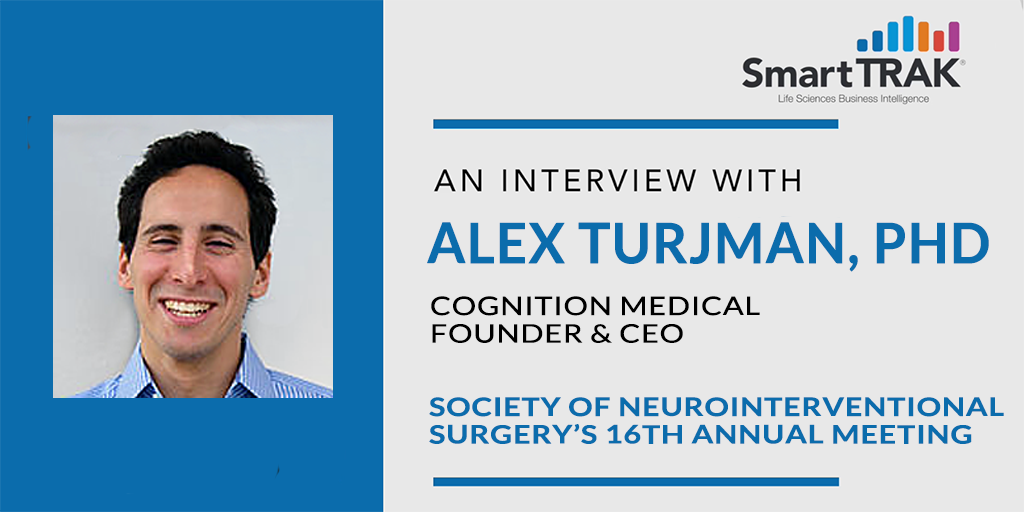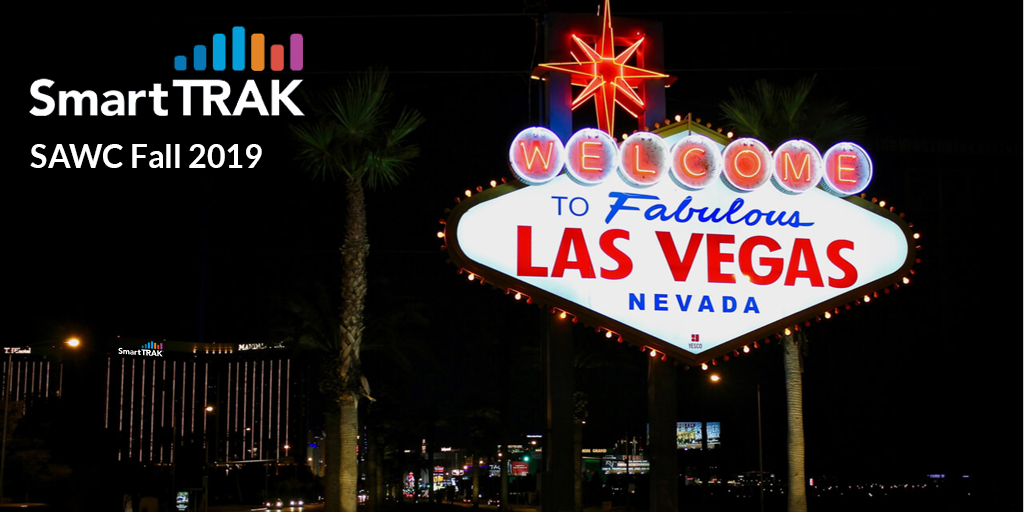 Cognition Medical discusses its next generation neurovascular technologies in an interview with SmartTRAK at SNIS 2019.
Cognition Medical discusses its next generation neurovascular technologies in an interview with SmartTRAK at SNIS 2019.
Anne Staylor, SmartTRAK's Managing Editor and Director of Advanced Technologies, caught up with Alex Turjman, PhD, CEO of startup Cognition Medical, at the Society of NeuroInterventional Surgery (SNIS) 16th Annual Meeting in Miami Beach, FL in July 2019. In the interview, they discussed the Company, its portfolio of next generation neurovascular catheters, and what’s next for Cognition Medical.
Click on the following video to listen to SmartTRAK’s interview with Dr. Turjman recorded live at SNIS 2019. A transcript of the interview is also provided below.
Anne Staylor here with BioMedGPS. Today, I'm talking with Alex Turjman, CEO of Cognition Medical, a startup developing interventional devices for acute ischemic stroke. Alex, thanks for talking with me today.
Alex Turjman: Hello, Anne. Thank you for having me.
Can you tell us a little bit about yourself and the company, maybe provide a brief overview regarding when it was founded and how it evolved to where it is today?
Alex Turjman: Absolutely. I'm French. I did my studies in the United States and started Cognition couple years back. Our goal is to improve the treatment of ischemic stroke patients and we have a couple of new technologies that we'd like to introduce to the market.
Great. Well, maybe you can talk a little bit about that. What are the technologies?
Alex Turjman: We have a full line of catheters that I think are new and interesting. We have a line of balloon guide catheters. We have a line of aspiration catheters. We have a line of balloon aspiration catheter, which is a new concept that I think is quite new and brings a second generation of aspiration devices, could bring the second generation aspiration devices to the market.
Tell me what are the advantages of that technology itself, the balloon guide aspiration catheter?
Alex Turjman: Balloon guide is really going further than what great companies like Medtronic or JNJ and others have done in this space of balloon guide catheters. We think that there's beautiful technology right now, but a lot of these catheters are getting old. I think that they can be replaced by newer technology that include newer materials, newer designs to give a better flexibility to the interventionalists to get the tools we need for the patients. In terms of the aspiration catheters, we think that we have found a platform that is absolutely excellent. We can deliver catheters faster, at least in our models, than the competition. In terms of balloon aspiration catheter, which is I think even a step further thinking about balloon catheters, is that it would allow you to ring a full occlusion, not just like a balloon catheter occlusion in the cervical or the beginning of the ICA, but really shut off all the inputs of the vasculature that are in front of the clot.
Meaning that you would be able to shut off the ACOM, you'd be able to shut off the ophthalmic and the PCOM. Basically, you would have only one way for the clot to move in particles. By doing one, a proximal embolic protection, and two, an added suction because of the balloon so that you don't have lateral flow with first generation aspiration catheter, you can produce potentially better results in terms of revascularization and potentially even turn this advantage into better lives and better recovery for the patients.
You're going to have to school me a little on this because I know they have balloon guide catheters, right? Then they use that to stop flow, so then they can introduce instruments, right? Then it goes distal to that, there's no flow, correct? Then in this situation right now, can't they introduce an aspiration catheter through the balloon guide catheter the way it is? How is this different?
Alex Turjman: Yeah, absolutely they can. The challenge with balloon catheters, and we also make balloon catheters. We do believe... We're very strong believers of balloon catheters. Our first line of devices is actually going to be balloon guiding catheters, but these are usually like a little stiff. They usually can't go too far out in the vasculature. I think so far it's been a limitation of the designs of the catheter, things that were not flexible enough to go really high up. What we've actually seen... I want to thank our partner physicians, Dr. Siddiqi, Dr. Levy, Dr. Fiorella, and the many others that have actually helped us understand these concepts, where actually you need to block off other arteries to do a full flow reversal. Because right now if you have a balloon guiding catheter and you do a cervical occlusion, then you still have flow that can actually come from the ACOM.
Contralateral flow.
Alex Turjman: Right. The anterior communicating artery, which actually its role in the case that one of the carotid is blocked, then flow would actually be coming from the other side of the circulation. Now, because you also have the ophthalmic and the PCOM, you can actually also have flow. With a first generation aspiration catheter, even though you've blocked the first segment of the ICA, then when you're starting the aspiration, a blot might be coming from the ACOM, the PCOM or the ophthalmic. I'm discounting the really smaller arteries because they don't make great contribution to flow. This is why I think a lot of procedural difficulties are happening where the physicians have to wrestle the tip of the catheter into the clot to really engage it. Then you can actually feel at home, imagine having your vacuum cleaner and you're actually trying to drag an object.
Unless you're really, really close to that object, you're just aspirating air instead of producing a suction force on this object. I think it's exactly what's happening right now. I think that in terms of the physicians that like Solumbra, the balloon aspiration catheter could be a phenomenal addition to the tools that they use because now you have a blockage of the flow, you have a nice occlusion, and you are free to bring back the stent into the clot. Even if you create emboli, then you're going to be able to clean that up through aspiration later on. I think that this is a powerful concept.
Make sure I understand, so then it is actually is better at occluding these communicating arteries.
Alex Turjman: Correct. Yes. There's about three major arteries that could feed the aspiration that we want to block off.
How does it work exactly? Where does the balloon sit? How is it different than where the current balloons are? How do you occlude it and maintain flow to the brain?
Alex Turjman: Typically, the balloon guiding catheters, and we make one, are sitting in the first segment of the internal carotid artery. That actually I think in itself shut off one very big supply of blood flow, which is the ICA itself. However, you can think about it in terms of a tree. It's like putting the balloon at the base of a trunk, but then after you have arteries that could feed three different branches, and namely there are actually three, the ACOM, the PCOM and the ophthalmic. We want to put the balloon in such a fashion that you're actually more distal to these branches and you can actually close off the contributions of these artery.
You thread it up more distally than the current balloon guide catheters.
Alex Turjman: Correct. It would be really at the base of the MCA would be the ideal location that could potentially be using the clinic.
Then as far as the aspiration, a lot of companies are coming out with these .071, .068, these large-bore catheters, does it come in a variety of sizes, or is it meant as a primary treatment combined with... You'd eliminate a regular balloon guide. You could use this as aspiration. Is that the goal?
Alex Turjman: Potentially, yes, but I think our first products are going to be a little bit more conventional. Just have the benefit of the modern materials and designs for the BG season, then later on try to have products that can navigate well really far. We believe that with a few sizes, we should be able to cover quite a wide range of uses.
Still will accept stent retrievers and things like that as part of the whole?
Alex Turjman: This is our goal.
You keep mentioning materials. Is that something you can discuss, the novel materials that you're using?
Alex Turjman: Right. I'm a material scientist by training, and we've been working quite hard to produce the finest materials to achieve our goals. I also have a background in mechanical engineering. We strive to design catheters in a different way to be able to produce better results than what's been on the market.
Is it like some sort of material combining different materials to create your own, or is this a super secret, you can't tell?
Alex Turjman: I think you hit me here. It's probably a super secret here. I'd have to kill you if I told you.
It's my job, Alex. You know that. That sounds like there's no one else on the market then with a balloon guide cath that can do what you're saying then.
Alex Turjman: I believe that right now there's no balloon aspiration catheter on the market.
That can do this. Are there any other key differentiators besides being able to block off more of the communicating arteries?
Alex Turjman: I think the idea is on top of the embolic protection having the block flow. In terms of fluid dynamics, you're actually changing the way that you're aspirating clot. You're not limited by the bore size, but you can actually put a segment of the artery in a state where it's almost acting as the catheter itself because of the pressure, and so you can pull much harder onto the clot.
Is there a name for your device yet?
Alex Turjman: We can't tell right now, but we have a secret name as well.
Okay, no problem. Where's this device at in development? Do you have any clinical experience? What about the regulatory status?
Alex Turjman: I think that for our BGC we actually have a design that we like very much. We've actually frozen the design For the line of aspiration catheters, we also have a design that we really like. For the balloon aspiration catheter, we are very advanced in developing this, but we probably want to wait and see how our first products are doing in clinic.
Have you had any first-in-man experience with it?
Alex Turjman: Not yet.
Are you working on bench -top, animals? Where are you at?
Alex Turjman: We've done bench-top. We've done animals. I think that the next step for us is to work on the regulatory to be able to test our devices in the US.
As far as your financing, how are you financed?
Alex Turjman: We have a very dedicated group of angel investors that is composed mainly of doctors, people that actually are doing these procedures. We're absolutely grateful to these people, not only for the funding that they bring, but mostly for the expertise and lecturing that they went through to explain to me what they needed. The rest of the group is mostly executives in med tech companies that have been very successful. We're actually also super grateful to these people because they've done this before. They've seen the story, and they're very generously giving us guidance.
As far as the funding, can you say how much you've raised and what you need next? What are your short-term goals?
Alex Turjman: Our short-term goals are to put our first devices on to submit 510(k)s to the FDA and do first-in-man. That would be a very good short term goal.
What do you need to do that? Do you have enough financing to get through that?
Alex Turjman: I believe so.
Can you say how much you've raised today?
Alex Turjman: We've raised today about $1.2 million, about a third came from France and the rest came from angel investors.
What would you say are your key achievements today?
Alex Turjman: I think finding a design that we love for the balloon guide catheter is something that we're very proud of and having a super platform for very large-bore aspiration catheters. We have a 0.72 and 0.75 catheters. We're super proud of our team for achieving these milestones. We've worked really hard on the third type of device is a balloon aspiration catheter that I think will be ready very soon.
Do you have a timeline for all these goals?
Alex Turjman: I think that the first devices should be available sometime during next year.
The first balloon guide cath or you mean your other access catheter?
Alex Turjman: I think the first balloon guide catheters and aspiration catheters and then we'll see.
You have to have that on the US. Market or OUS market?
Alex Turjman: US market.
By 2020.
Alex Turjman: For 2020.
What are your big challenges ahead then? What do you see as some of your biggest challenges?
Alex Turjman: Well, I think that finding talent that can help us achieve our commercialization goals is going to be a big challenge and taking this organization through transition of an R&D group to full fledge company that can commercialize devices in the competitive US market is something that is going to be a challenge, but we have a very good group of advisors. We actually just welcomed Maria Aboytes to our board of directors. Maria has been in countless successful medical device companies. She was the founder of Medina Medical that was acquired by Medtronic. She worked at Ardian. She worked at Concentric. She worked at Nfocus I believe as well. Maria is a whiz at technology, but I think she also through her different experiences acquired the business vision that is needed to steer a startup in the right direction.
Our other board member is John Hardin, who was VP of sales and marketing at Covidien just before the merger with Medtronic. John is a very talented sales and businessman in general and sales and marketing person. He knows virtually everybody in neuro, especially the very high-powered sales people there. I think we're going to lean on him to develop this venture. I also want to mention Bob Mellen, who has been a special advisor. Bob was the president of Bard Peripheral and became the senior vice president of business development for Bard. Now he works for a VC group in the Bay Area called Aphelion. Bob has been absolutely essential in this organization. He has a lot of strategic vision, and he keeps me focused to achieve our goals.
What do you think are the keys to your near term success?
Alex Turjman: I believe that the working with the key opinion leaders and the people that advise us will be the key to our success and having their feedback in the clinical setting is going to be our key to success. I think we definitely want to have Dr. Levy and Dr. Siddiqi in Buffalo try our devices. These were our first supporters. The help Dr. Victor Pereira, who is in Toronto. We want to have the opinion of Dr. Baxter, Dr. John Kreuzberg at Emory and Grady in Atlanta, who's local because we're based in Atlanta. I think we have a number of other clinicians. I want to especially also thank Dr. Amir Hassan, who is a very up and coming interventional neurologist who's based in south Texas and who does absolutely beautiful work. He is phenomenal and he has given us a lot of feedback so far. We definitely want to include him also in this group of early users.
What about strategics? I know there's a lot of companies that show interest. Have you seen a lot of interest from some of the big neurovascular companies because as a little company coming out onto the market can be quite challenging?
Alex Turjman: I believe so. I think that there are a number of big companies that we've been talking to. I would say that we presented to pretty much everybody. I think some companies are easier to approach than others, but it's been a fun meeting. We also approached emerging companies like Imperative Care and I want to thank Mr. Fred Khosravi, who is the absolute medtech guru. And he's given us time to present a concept. I believe he'll be soon a very large company. The diversification I believe of these large companies is interesting for small companies because now we have more actors to talk to.
What's next for Cognition Medical?
Alex Turjman: I think we want to execute. This is absolutely our priority, but we're also thinking about new devices. I think we strive to constantly innovate. Our team is small, but we're also very committed to innovation. I believe there's new devices that can compliment our existing line that we'll be working on.
Well, thank you so much for your time, Alex.
Alex Turjman: I appreciate your time Anne.
Subscribe to the SmartTRAK blog to make sure you don't miss any of Anne's upcoming posts.
SmartTRAK is the leading source of competitive intelligence used by the top ten global orthopedic & top 15 wound care companies. If you would like a demo of what SmartTRAK has to offer and how we can help increase proficiency, improve productivity and reduce costs for your company, just click the button below.





